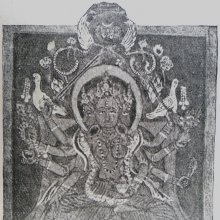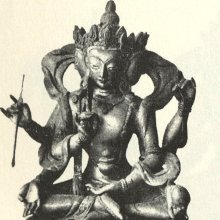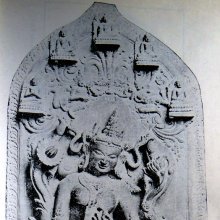Mahamayuri, Mahāmāyūrī, Mahāmayūrī, Maha-mayuri: 8 definitions
Introduction:
Mahamayuri means something in Buddhism, Pali, Hinduism, Sanskrit. If you want to know the exact meaning, history, etymology or English translation of this term then check out the descriptions on this page. Add your comment or reference to a book if you want to contribute to this summary article.
Images (photo gallery)
In Buddhism
Tibetan Buddhism (Vajrayana or tantric Buddhism)
Source: Wisdom Library: Tibetan BuddhismMahāmāyūrī (महामायूरी) is the name of Vidyārājñī (i.e., “wisdom queen”) mentioned as attending the teachings in the 6th century Mañjuśrīmūlakalpa: one of the largest Kriyā Tantras devoted to Mañjuśrī (the Bodhisattva of wisdom) representing an encyclopedia of knowledge primarily concerned with ritualistic elements in Buddhism. The teachings in this text originate from Mañjuśrī and were taught to and by Buddha Śākyamuni in the presence of a large audience (including Mahāmāyūrī).
Source: archive.org: The Indian Buddhist Iconography1) Mahāmāyūrī (महामायूरी) refers to one of the various emanations of Amoghasiddhi, as mentioned in the 5th-century Sādhanamālā (a collection of sādhana texts that contain detailed instructions for rituals).—Her Colour is green; her Āsana is the ardhaparyaṅka; she has three faces and six arms.—Mahāmāyūrī is another goddess of the Pañcarakṣā group, and is affiliated to Amoghasiddhi in the same way as the other members of the group are affiliated to one or another of the Dhyāni Buddhas.
The Dhyāna (meditation instructions) of Mahāmāyūrī described in the Sādhanamālā as follows:—
“The worshipper should visualise himself as Mahāmāyūrī, who hasa green complexion, six arms, and three faces, each endowed with three eyes. Her right and left faces are of blue and white colour respectively. She shows in her three light hands the peacock’s feathers, the arrow and the varada-mudrā, and similarly, in the three left hands the jewel, the bow, and the water-vessel on the lap. She is decked in wonderful ornaments, displays the sentiment of passionate love, is youthful, has her seat on, and the radiance of the moon, sits in the ardhaparyaṅka attitude, and bears the image of Amoghasiddhi on the crown.”
2) Mahāmāyūrī (महामायूरी) refers to one of the five Protector Goddesses (Rakṣa or Pañcarakṣa), commonly depicted in Buddhist Iconography, and mentioned in the 11th-century Niṣpannayogāvalī of Mahāpaṇḍita Abhayākara.—Her Colour is white; her Symbol is the discus; she has four faces and ten arms.—Her Colour is green; her Symbol is the mendicant on bowl; she has three faces and eight arms.—Mahāmāyūrī is the fifth and the last deity of the Pañcarakṣā-maṇḍala of the Niṣpannyogāvalī.
Mahāmāyūrī is described in Niṣpannayogāvalī as follows:—
“In the North on the orb of the moon on a double lotus, with the halo of the moon and sitting on a man, there is Mahāmāyūrī. She is green in colour, and her three faces show the green, the white and the blue colour in the first, the right and the left faces respectively. She is eight-armed. In the four right hands she holds 1. the jewel, 2. the arrow, 3. the varada-mudrā and 4. the sword. In the four left hands she shows 1. the mendicant on the bowl, 2. the bow, 3. the jar on the lap showering jewels, and 4 the banner marked with the double vajra and the jewel”
The Sādhanamālā describes Mahāmāyūrī somewhat differently.—Here she is endowed with the yellow colour. But in both places she is eight-armed. Like the other Rakṣā deities Mahāmāyūrī is widely represented.

Tibetan Buddhism includes schools such as Nyingma, Kadampa, Kagyu and Gelug. Their primary canon of literature is divided in two broad categories: The Kangyur, which consists of Buddha’s words, and the Tengyur, which includes commentaries from various sources. Esotericism and tantra techniques (vajrayāna) are collected indepently.
General definition (in Buddhism)
Source: Cambridge Digital Library: Pañcarakṣā, SaptavāraMahāmāyūrī (महामायूरी) refers to the second of “five protections” (pañcarākṣa) classified as a dhāraṇī according to a 17th-century Sanskrit manuscript from Nepal .—The earliest evidence for texts grouped together as the “five great dhāraṇīs” comes from Tibetan catalogues around 800 CE. These scriptures include spells, enumerations of benefits and ritual instructions for use.
Languages of India and abroad
Sanskrit dictionary
Source: DDSA: The practical Sanskrit-English dictionaryMahāmayūrī (महामयूरी).—Name of Buddhist goddess.
Mahāmayūrī is a Sanskrit compound consisting of the terms mahā and mayūrī (मयूरी).
Source: Cologne Digital Sanskrit Dictionaries: Edgerton Buddhist Hybrid Sanskrit DictionaryMahāmāyūrī (महामायूरी).—(also Māyūrī, q.v.), name of a work (our Mahā-Māyūrī) and of the charms it contains: (Ārya-)Mañjuśrīmūlakalpa 109.28; Waldschmidt, Kl. Sanskrit Texte 4, 152 ff.; Lévi, JA 1915.19 ff.; personified, (Ārya-)Mañjuśrīmūlakalpa 312.6; Sādhanamālā 177.11 etc.; 402.4; seemingly regarded as a rakṣā, q.v., in Sādhanamālā (compare [Boehtlingk and Roth] 5.648 s.v. mahā- rakṣā), where this form replaces Mārīcī of the list in Dharmasaṃgraha 5 (but [Boehtlingk and Roth]'s reference to ‘Vjutp.’, i.e. Mahāvyutpatti, is a mystery to me, since I have been unable to find this list in either of the edd. of Mahāvyutpatti accessible to me); in Mūla-Sarvāstivāda-Vinaya i.286.15 ff. applied to a short charm to cure snakebite.
Source: Cologne Digital Sanskrit Dictionaries: Monier-Williams Sanskrit-English Dictionary1) Mahāmayūrī (महामयूरी):—[=mahā-mayūrī] [from mahā > mah] f. Name of a Buddhist goddess, [Dharmasaṃgraha 5] (= -māyūrī q.v.)
2) Mahāmāyūrī (महामायूरी):—[=mahā-māyūrī] [from mahā-māyūra > mahā > mah] f. (with Buddhists) Name of one of the 5 amulets and of one of the 5 tutelary goddesses (cf. -mayūrī)
[Sanskrit to German]
Sanskrit, also spelled संस्कृतम् (saṃskṛtam), is an ancient language of India commonly seen as the grandmother of the Indo-European language family (even English!). Closely allied with Prakrit and Pali, Sanskrit is more exhaustive in both grammar and terms and has the most extensive collection of literature in the world, greatly surpassing its sister-languages Greek and Latin.
See also (Relevant definitions)
Partial matches: Maha, Mayuri.
Starts with: Mahamayuristotra.
Full-text (+664): Maharaksha, Pancaraksha, Krimila, Vasubhadra, Tripura, Mayuri, Trishulapani, Aravala, Asani, Karali, Mardana, Madana, Upakalaka, Kalashodari, Rohini, Sutanu, Varuni, Gandhari, Anayasa, Kaki.
Relevant text
Search found 7 books and stories containing Mahamayuri, Mahāmāyūrī, Mahāmayūrī, Maha-mayuri, Mahā-mayūrī, Mahā-māyūrī; (plurals include: Mahamayuris, Mahāmāyūrīs, Mahāmayūrīs, mayuris, mayūrīs, māyūrīs). You can also click to the full overview containing English textual excerpts. Below are direct links for the most relevant articles:
The Indian Buddhist Iconography (by Benoytosh Bhattachacharyya)
Figure 200 - Five Protectresses (5): Mahāmāyūrī
A Historical Study of Kaushambi (by Nirja Sharma)
Sculptures from Kaushambi < [Chapter 4]
Maha Prajnaparamita Sastra (by Gelongma Karma Migme Chödrön)
Appendix 2 - Ahicchatra (capital of northern Pañcala, present Ramnagar) < [Chapter V - Rājagṛha]
Appendix 1 - Pūrṇavardhana or Puṇḍravardhana (city and district of Bengal) < [Chapter V - Rājagṛha]
Appendix 1 - Story of the nāga-king Elapatra < [Chapter XL - The Four Fearlessnesses and the Four Unobstructed Knowledges]
The Skanda Purana (by G. V. Tagare)
Chapter 62 - The Practice of Mahāvidyā < [Section 2 - Kaumārikā-khaṇḍa]
Bhesajjakkhandhaka (Chapter on Medicine) (by Hin-tak Sik)
Toxicology (Agadatantra) < [Chapter 5 - Diseases and Treatments in the Chapter on Medicine]
Harsha-charita (by Bāṇabhaṭṭa)
Related products



